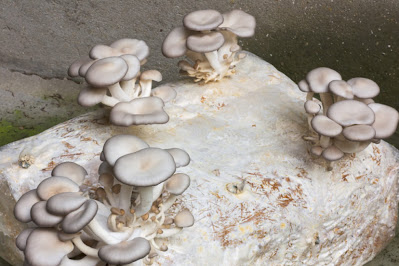What's going on everyone. Kevin from Epic Gardening here. Inside of this box looks like some packing peanuts, but in fact, we have something that's going to produce something pretty awesome and pretty amazing. This is a Shiitake mushroom patch from fungi perfect. And so, I've done a bunch of blog on growing mushrooms or I will be in the future depending on when you're watching this blog and Shiitake are probably one of my favorite mushrooms, I have to be honest. But the crazy part about them is they are exceptionally expensive at the grocery store. You know, $13 to $16 on a per pound which is to me... blows my mind and it's a bit pricey. So I figured, why not learn how to grow these at home and starting out with the absolute basics with a kit. Of course, we can get into inoculating logs and things like that in the future. But for now, we're gonna grow very, very simply. Now, the first thing you do when you get your Shiitake patch is you want to inspect it. So this has already been inoculated and the mycelium has cultivated and grown through the substrate and so basically the roots or most of the structure of the mushroom is already done and that would be this white color here, that's the mycelium. So what you want to do first is you kind of want to look at it and say, "Is it cracked? Is it broken at all?" And if it is broken, what you want to do, is put it back in the box. Now, fortunately, mine looks okay but if it's not, you're going to want to put it back in the box for another week or so to let the mycelial network, really re-adhere this chunk, this patch back together. Fortunately, I am fine so I don't have to do that. But my next step here is to take a look at this number, right here. You can see it and it says, "10/30", that means this patch was wrapped up on October 30th. Now, you really don't want to start the process of growing your Shiitake mushroom until 40 days have passed from the date that's right there. So, we're actually recording this on December 10th. So, it's I think it is about 41 days so we're just right about there.
So, now we can move on to the next step. So, the next step is pretty darn simple. You're just inspecting the patch from the outside and seeing what it looks like. If it looks sort of popcorny with white and brown spots on it, but there aren't any baby mushrooms or primordial forming then what you want to do is refrigerate it for 3 to 5 days. That's what we're going to do because that's what mine looks like. However, if yours looks like the same thing, popcorny but also there are some baby mushrooms popping out, then you want to go straight to cultivation. I don't have to do that, which is actually good because that's probably the more likely scenario is to be where I am, where you have to actually go through the refrigeration and then the soaking process and then into cultivation. So, fortunately, mine's like that so I get to show you guys the full process of growing your Shiitakes. So, this step is pretty self-explanatory guys. This is going in the fridge for 3 to 5 days. I'm going to put it right here on the top shelf and then after that what we're going to do is, we're actually gonna soak it in cold filtered water. Make sure there are no contaminants in that water because we don't want to damage the mycelium and then we're going to go into the growing process for the Shiitake.
So, in three days, we will be right back. 1, 2, 3! And we're back. It's time the Shiitake has been refrigerated for 3 days. So, it's time to bring it to the next step which is outside and that is soaking it. But we have a couple things to go over because you can't just dump it into normal tap water. You have to do a couple different things to make sure that water is ready to receive the mushroom patch. So, let's go take a look. So, we've got our patch outside, but why is it outside? Well, you have to soak your Shiitake patch for 2 to 4 hours in the water, but not just any water. You can't be dumping tap water straight into a bucket and then dunking it in. Because the chlorine in there is going to mess with the mycelium. So what do you have to do? Well, first of all, you can't go straight to the other extreme and use distilled water, you have to dechlorinate your normal water. So, the way that I'm doing that, you could certainly just grab a bucket, fill it with water and then leave it out for 24 hours and that's going to off-gas most of the chlorine. But to speed it up, I've just thrown an air pump in here so you can see it bubbling away and if you do that, the 24 hours can shrink to somewhere around 2 to 4 hours or so. So, we're about an hour in. I'm just gonna let it go a little bit longer and then we're going to put this in here and what we're going to do is, we're going to drop it right in, but it's gonna float because it's buoyant and so I'm going to grab a plate and then just put something else on top of that plate to make sure we fully submerged it for about 2 to 4 hours. Right, our water has been successfully oxygenated. So all the chlorine should be out of it by now.
I actually went a little over the 2 to 4 hours recommended to that. So it should be completely fine. So now we have to soak this. So what you do is, you actually cut this open. I'm going to give myself a little extra room to get this out. We have to soak this for 2 to 4 hours in this cold water but it's buoyant so I'll show you. It'll end up floating and so what we want to do... is we want to take like a plate and then something heavy and put it down. So, it actually will stay on there. Sit down there, excuse me. So, we're gonna soak it for 2 to 4 hours... Boom! ...and then we'll be back for its final resting place. 3 days later. Does this look like a big toasted marshmallow or a Shiitake mushroom patch? I don't know about you but I'm happy that it is the Shiitake mushrooms. So, you can see, you've got 1, 2, 3, 4, 5, 6, 7, 8, 9, 10, 11, 12, 13, 14, 15, 16, 17, 18! There's one little guy right there. 18 different individual Shiitake mushrooms that are starting and it's been about three days, I think, since we last filmed which you probably just saw me dunking it and then placing it. So, this is coming along like crazy. The growth is absolutely insane and I think it's going to take maybe another 8 to 10 days to get an actual full flesh. Cut all these off. Enjoy them in some delicious thing and then we can actually get this to flush a couple more times and then from there maybe even inoculate some logs with the spawn. So, we'll see, but pretty pleased with how it's going so far. So, what's interesting are they actually start as these little brown toasted looking spots which are why it kind of does look like a toasted mushroom, but very quickly they grow up into this little baby, and then eventually you're going to see them grow up into their full form. They're evolving like Pokemon everyone. It's been two and a half more days guys and as you can see the growth is insane and it's time to harvest some of these. Not all! I'm going to let some of these grow a little bit longer but some of them are definitely getting the chop. So, I'm just going to take, it's a standard paring knife.
 |
Now, the last thing you're going to do here is just top off the little bits of garlic so you have something nice and crunchy in those caps and you want to heat your oven up to 350 degrees and you want to bake it uncovered for 30 to 40 minutes. And let me just tell you, the sizzle and the smell that comes out is absolutely incredible. All right guys the moment is here. It's time to taste these bad boys and I don't know about you but for me, growing mushrooms is so different than growing plants. Because it just feels different to harvest this. Cook it, prepare it, and now eat it, as it does compare to something I grow outside. I mean, it just does feel different and it's certainly more of a substantial tasting thing to me. I mean, there's more heft to it I guess, you could say there's more protein in it. Certainly, then many plants you're going to eat, and let's go ahead and try it out. I feel like... Mm. My words are in my mouth. I'm eating with my mouth full. Okay, the flavor is crazy good. Remember, it was just olive oil, apple cider vinegar, and some soy sauce and some garlic. So, that doesn't really take away from the flavor of the Shiitake. It's still a delicious Shiitake mushroom but I feel like all those three...
You have your acid, you have your fat, you have your sort of salty flavoring and then you have some garlic for that flat seasoning, that spice it brings all out. So, the Paul Stamets recipe is, Epic Gardening approved. Although, I don't think he needs my approval but guys... Sorry, I need to get some more of this. Hold on, one second. If this was interesting to you remember this was just the first flush that we got out of the patch. You can get more than this out of the patch if you let it rest for a bit. Cold shock it again and then put it back into the humidity dome and see if you can get 2 maybe 3 more flushes out of it because there's more, there's more energy in the hardwood sawdust for that mycelium to produce new fruit bodies aka these Shiitakes here. And one more thing you saw me cut off all the stems. I'm not going to throw those away. I'm actually going to dehydrate them and then when it comes time to make some soups, I'm going to throw that back in and make some nice mushroom vegetable soup base for potentially some stews coming up in the future we'll see. So, I hope you guys enjoyed it? Thank you so much for watching. I've got a plate of Shiitakes to finish. So, I'm going to catch you in the next episode. Good luck in the garden and keep on growing.





No comments:
Post a Comment